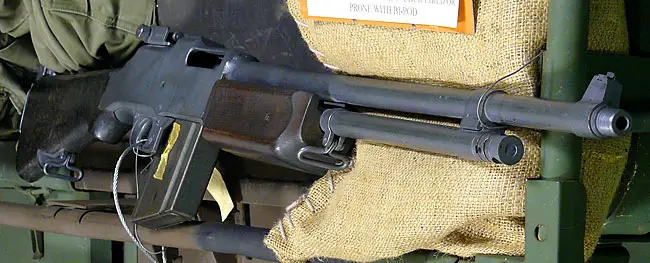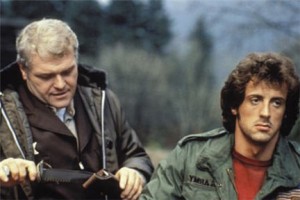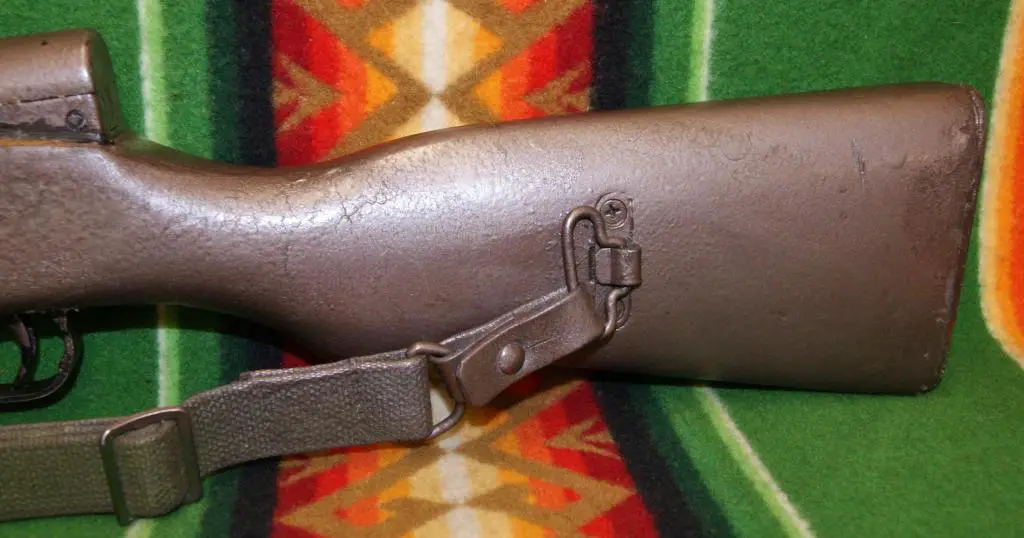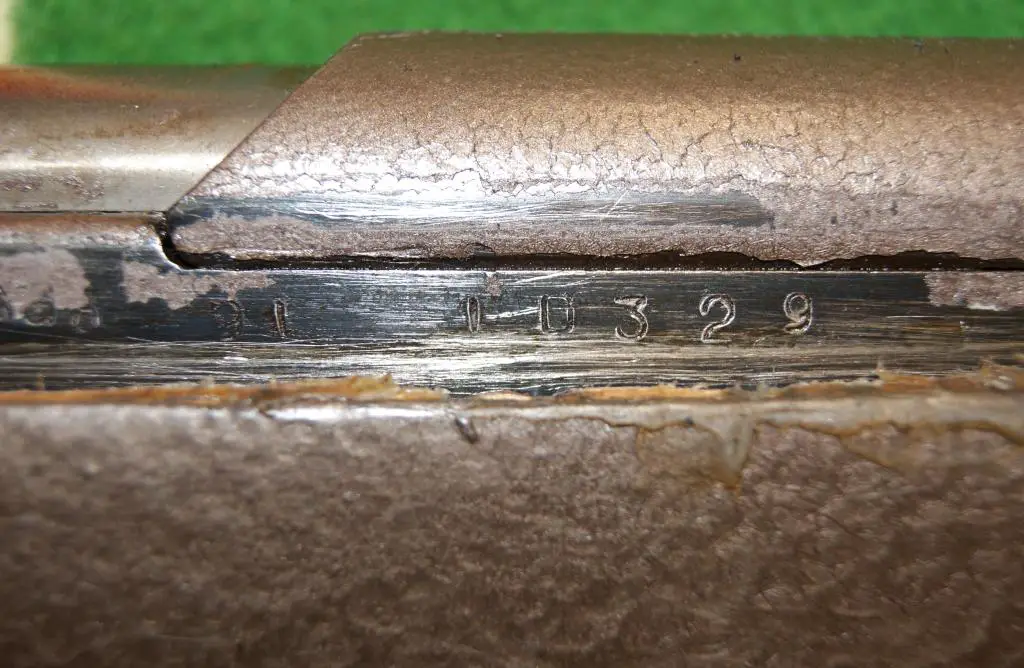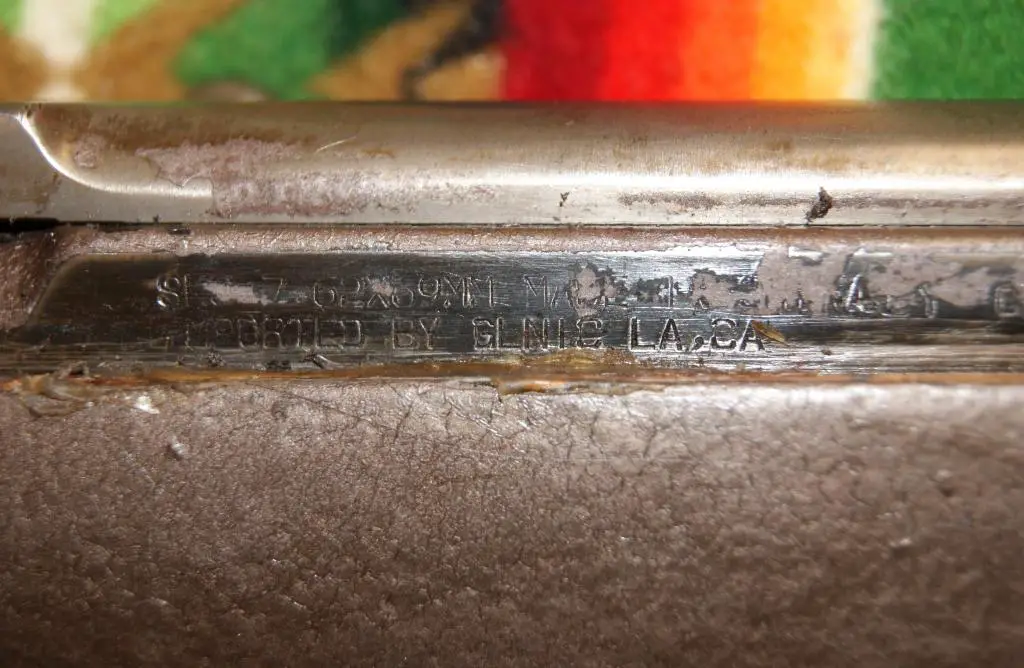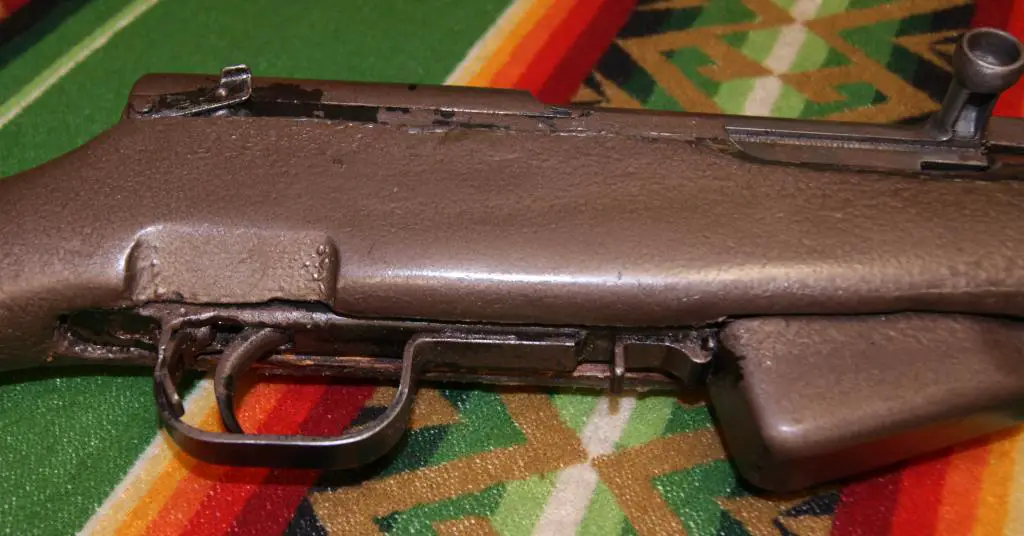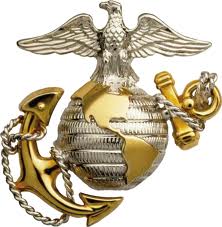 The new, and excellent, memoir of Marine rifleman Sterling Mace (written with pro writer Nick Allen), Battleground Pacific, goes into some detail about what Mace thought about weapons and equipment. Here are some quotes from the book:
The new, and excellent, memoir of Marine rifleman Sterling Mace (written with pro writer Nick Allen), Battleground Pacific, goes into some detail about what Mace thought about weapons and equipment. Here are some quotes from the book:
It was George [McNevin, a friend of Mace’s before the war that he ran into on the island of Pavuvu, as the Marines prepared for the assault on Peleliu] who recommended I choose the Browning automatic rifle (BAR) as my weapon, as it suited a left-handed rifleman better than an M1 rifle….
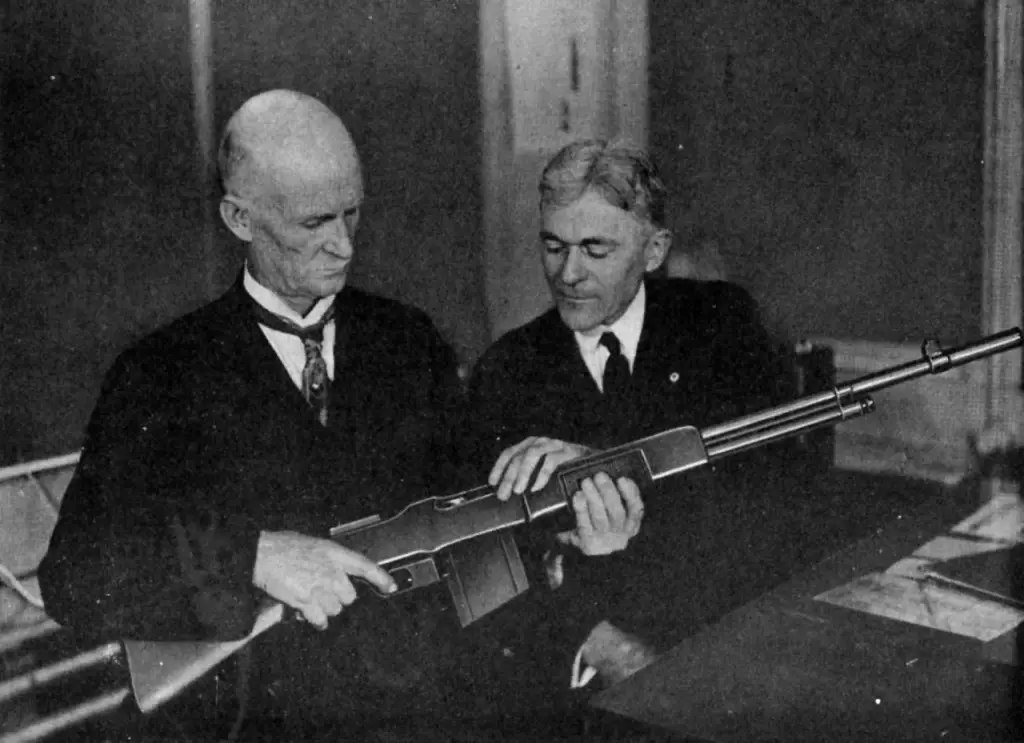
John M. Browning in 1921 with Mr Burton of Winchester and the category-creating Browning Automatic Rifle. The services would later add a bipod and mess with the controls; not everyone thought these were improvements.
When Mace and his fellow Marine boots landed on the friendly-held island of Pavuvu, they had no weapons with them; indeed, he’d only handled weapons in boot camp, and during a detail at the Brooklyn Naval Yard.
Our job at the naval yard was the highly classified, top-secret duty of guarding the dockworkers payroll. That duty entailed carrying shotguns and Reising submachineguns. The shotguns were okay, but the Reising was so cheaply built that I was afraid to touch the damn thing. It seemed like it would go off at any second if you just looked at it funny.
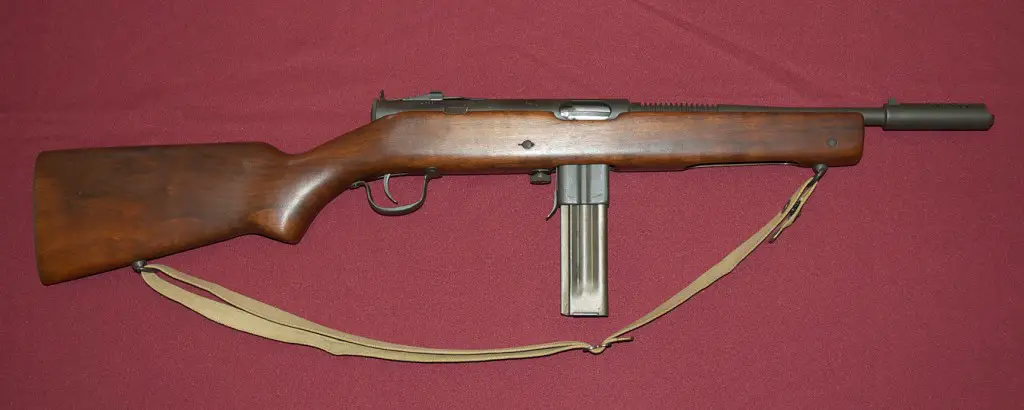
A Reising Model 50, the variant most used by the Navy and the Marines. This one has a 12-round single-column magazine in place of the usual smooth-sided dual-column 20-rounder.
Back on Pavuvu, however, the lack of weapons meant more than we knew.
We didn’t know it then – as we milled around the dock, waiting for someone to tell us where to go and what to do – but if you didn’t have specialized weapons training, in, say, flamethrowers or machine guns, the chances were pretty good that you’d be a rifleman. End of story.
The Marine Corps rifleman. Every marine wanted to be like him. No Marine wanted to be him. We were unique in our class and phylum. The lowest common denominators. Yet a whole operation – from the simplest maneuver to the grandest assault – revolved around the man and his rifle…. Our sole potential was killing a lot of Japanese. God, we loved the Marine Corps!
As riflemen, firearms were a frequent subject of discusion, a professional interest, you mihght say. For some, it was a generational heritage. Like the platoon leader Mace discusses, as he runs through some “typical” Marines he knew:
Marines like… Lieut. William “Bill” Bauerschmidt, USMC, from Pottstown, Pennsylvania, recipient of the Silver Star for bravery – with his high-top lace-up boots that were never tied up all the way but instead they flared out at the tops. Bill carried his dad’s World War I .45 service revolver into combat – engraved with the initials WB on its grip – dearly wanting to make his father proud.
You’ll have to read the book to see just how Bill Bauerschmidt made his father proud. Mace runs through his squad and platoon mates, identifying them by an unusual habit (“never wore a helmet, only a cap”) or by the weapon they carried (“He was only 5’6″ but he carried the 19-pound BAR”). You’ll know, as you read this, that not all of them will survive, not with Peleliu, Ngesebus and Okinawa in their future.
Along with these brief tone-pictures of his platoon-mates, Mace describes in precise detail what the well-dressed BAR gunner was sporting on the scenic beaches of Peleliu in September, 1944:
My equipment was easy to put on, although it weighed more than the average Marines care, because of my job as a BAR gunner. My pack itself was nothing, with its poncho looked over the top and an entrenching tool fastened to its center. To secure it, the pack was affixed to a wide strap which ran down my spine, attaching to the rear of my cartridge belt at the waist. Therefore, putting it on was akin to donning a jacket. One arm went through one strap, and then the other, leaving only the clasp for the cartridge belt to fasten below my abdomen, securing the whole getup as one piece.
On the cartridge belt were six BAR magazine pouches, three on each side, holding two magazines apiece. That’s 20 rounds a magazine, making a total of 240 rounds of .30-06 ammo, double what a marine with an M1 rifle carried. Also I had two canteens of water and a little first-aid pouch on my belt.
Strapped across my chest and hanging to my waist was my gas-mask bag, with a gas mask inside. Add that to the contents of my pack, housing three boxes of K rations, a change of socks, a dungaree cap, and a waterproof bag with my personal effects – a pocket New Testament and my wallet, including the card I received when I cross the equator – and that made me combat ready. I had to carry light, given that the weight of my BAR was another 19 pounds to shoulder – and that’s 19 pounds without the bipod fixed to the end of the barrel. The bipod was the first thing I took off on Pavuvu; it made the BAR unbalanced and unwieldy.
My head was covered with my pisspot (helmet), unbuckled at the chinstrap, swathed with the fall motif camouflage cover. On my legs I had a pair of tan canvas leggings, enfolding my dungaree pants close to my legs.
That was what the well-dressed Marine was wearing to His Imperial Majesty’s ball on Peleliu. Mace took some camouflage face-paint that other Marines were passing around, and drew a whimsical mustache on his face.
On his way into the beach, he ran his hands over the cool steel receiver of his BAR. It was the only thing he could count on to keep him alive.
Epilogue:
Photographer ME Stanley has some photos of battlefield relics, including some from Peleliu, taken long after the war.
A Remarkable Defensive Gun Non-Use
You don’t expect a 2nd Lieutenant to demonstrate much beyond potential. But this 2nd Lt. in the West Virginia Air National Guard is already a veteran of the Marines and a husband and father experienced in the world. He recently was in a local Walmart when a woman began screaming for help. A man was holding a knife to her neck.
Police eventually responded to the scene and put the suspect in handcuffs. Nelson said he later discovered that the woman he was threatening was his own mother. He turned the knife on his mom when she refused to buy him a gun, according to a copy of the police report obtained by TheBlaze.
Nelson and his wife both carry everywhere they can, legally, to protect themselves and their family. In this case, Nelson protected two strangers — the threatened woman and her disturbed son.
Nelson, remarkably, resolved the situation by only displaying his firearm without drawing it, and using his maturity and command presence — yeah, a 2nd john’s command presence — to talk the angry man down. He talked him into letting his mother go. Then he talked him into stopping threatening himself, which was what he did after releasing his mom. Then he talked him into putting the knife down. Finally, he talked him out of running away, and into sitting down and waiting for the cops.
It was a bravura performance — and the firearm never left the holster, although it seems to have contributed greatly to Nelson’s command of the situation.
Nelson had nothing but good things to say about the way officers with the Del Rio Police Department handled the situation. He said the officers commended him for his handling of the situation — and because he never brandished or fired his weapon, officers said “no thanks” when he asked if they wanted to see his legal concealed carry permit.
Would a lot more stand-offs end like this, instead of the usual shooting, if they were met by armed, calm citizens rather than a police Steroids Weapons And Tantrum squad call-out? Hard to say. Every threatener is different, and so is every threat. Cops talk a lot of suspects into giving up and laying down weapons every day, and those cases seldom make the papers. Nelson might have wound up shooting the guy. And in some jurisdictions, cops and a district attorney would have jumped at the chance to “nail” Nelson. Fortunately, West Virginia is not New Jersey, so he didn’t get the Brian Aitken treatment.
“The number one reason I carry is to protect my family. It’s a God-given, constitutional right that I fully, 100 percent stand behind,” Nelson told TheBlaze. “Secondly, I love my fellow Americans, and if I’m in a position to help one of them, obviously, I want to do that.”
“I immediately felt responsible for that lady’s life,” he added. “If I’m in a position to help someone and I don’t, I would feel just as bad as the guy who does wrong.”
Apparently this guy is in flight training, heading for the ranks of pilots, which is where the Air Force tends to find its leaders. They’re lucky to have such a sensible and mature fellow. He’s also a delegate in the WV legislature, which seems like another good place to have a sensible and mature man.
What is bothersome, he explained, is the fact that there are tons of stories about responsible armed citizens that never get reported by most of the media. He may have a point — this incident has barely been reported and it occurred back in April.
“They never let us tell our side of the story,” Nelson said. “We hope that some good can come out of our story and let people know what is really going on.”
via National Guardsman’s Trip to Walmart With His Family Turns Into Potentially Deadly Nightmare — Then His Training Kicked In | TheBlaze.com.
This is another reason we’re leery of the emphasis on the quick-draw in so much use of force and handgun training. Sometimes the best place for it is in the holster. When you need it, you are much, much more likely to have the time to draw it (and even prepare it) than you are to be assaulted out of a cold situation.
 Police training would have emphasized an early draw in this situation. The suspect has deployed deadly force (the knife), and cops are keenly aware of justr how deadly a knife is, and how quickly a knife-wielding bad guy can close normal distances. In addition to that, police policy is, generally, to meet force with overwhelming force to impress the suspect into immediate surrender, and it works great on rational suspects. But a force escalation produces unpredictable results with irrational suspects. The majority of them can be talked down (and this does seem to be what happens in most of these cases, policy notwithstanding). Those that resist often resist in a slow-motion, dare-you-to-shoot-me way. There is usually time for a less-kinetic approach to these less-kinetic threats.
Police training would have emphasized an early draw in this situation. The suspect has deployed deadly force (the knife), and cops are keenly aware of justr how deadly a knife is, and how quickly a knife-wielding bad guy can close normal distances. In addition to that, police policy is, generally, to meet force with overwhelming force to impress the suspect into immediate surrender, and it works great on rational suspects. But a force escalation produces unpredictable results with irrational suspects. The majority of them can be talked down (and this does seem to be what happens in most of these cases, policy notwithstanding). Those that resist often resist in a slow-motion, dare-you-to-shoot-me way. There is usually time for a less-kinetic approach to these less-kinetic threats.
So what should police training emphasize? In a perfect world, individualized judgment. Simple rules and mantras are probably necessary if you insist on deploying some 80-IQ blockheads among your cops, but you want to have pretty good liability coverage if that’s your plan. (In a lot of jurisdictions, some pretty bright cops have slipped into the force — heh).
It’s not like waving the gun does the cops much good. Movies notwithstanding, most shooters can not make the shot on a bobbing, weaving perp’s head as he crouches behind a hostage at a few meters. IPSC hostage targets just sit there, and nothing but points hang in the balance. Even “moving” targets usually have either limited, one-axis, or repetitive motion. A real human head is a very hard thing to hit, especially one that’s wrapped around the idea that someone wants to shoot it.
Finally, we as a nation are scandalously overdue for doing something about the problem of mental illness. (Clayton Cramer made these points well in the University of Connecticut Law Review [HTML intro / .pdf article] this past May — for all of you who thought it was just a basketball school, they train lawyers too). We need to have new authorities for involuntary commitment, new authorities for involuntary outpatient treatment (“probation” and “parole” equivalents), and facilities to confine and treat the involuntarily committed. These will be expensive, but will remove a major drain on the economy. Our experiment with deinstitutionalization is forty years old, and it’s a sanguinary failure. It’s time to end it with humane reinstitutionalization for the dangerous mentally ill.
Oh, no, Bubba got hold of the SKS!
In the Continuing Adventures of Bubba the Gunsmith™, we’ve seen him savage Glocks (and more Glocks), Lugers (and more Lugers, en français aussi) and mangle 1911s and more 1911s. In long guns, he’s had his way with more ARs than we could count, like this one and this one (something about the modularity of the AR system is irresistible to slow minds and fat fingers), and solved the notorious “tight chamber” er, “problem,” of a National Match M1A barrel. Most recently, we saw his Century Arms International iteration hacking AKs with a Foredom tool.
With the entertaining website BubbaGun.com apparently paws up, we stand alone between the pipe wrenches and rattle cans on one flank, and the pool of remaining decent firearms on the other. And we seem to be constantly retreating. Take this SKS, for example.
And take it, the Lewiston, Idaho dealer would like you to: he has it on GunBroker for $149 (+$37 shipping to your FFL). It’s an ordinary preban-import Chinese military SKS, the sort that sells in decent condition for $250 right now. Now, SKSes are great guns; they’re a blast to shoot, reliable as a shovel and forgiving of abuse, have an interesting military history (it was the main arm of many NVA units, and a sought after Vietnam souvenir). It fires common and inexpensive ammo, is small and handy, and looks like a real military weapon, if a dated one. It’s a great gateway drug to the world of military collecting, and you could always hunt with it (although many jurisdictions frown on 10-round magazines in the woods in deer season, and Elmer Fudd is not going to like seeing a bayonet).
But this one has lost its value, and its looks; Bubba has been at it with the usual tools of his trade. First, the rattle-can refinish job:
That’s not some crummy polymer stock; that’s the original Chinese hardwood. (It might even be laminate under there, but odds are it isn’t). But Bubba didn’t stop with spraying the stock. In Bubba’s trailer, if a little Krylon is good, the whole can is better. That’s why it has all the wrinkles: right on the can, it says something like, “apply in thin coats,” but that would require you to read the can. Or at least, to read.
And we’re talking about Bubba here. So he not only went rattle-can, he chose from Bubba The Gunsmith™’s three-tone color pallette: Flat Black? Semi-Gloss Black? Nope, he went with the ever-so-tactical Feces Brown. Because, he’ll tell you, black is a color that does not occur much in nature, unlike feces. Er, we mean, brown.
He also sprayed, as you can see, the fittings and fixtures, like the sling swivel. And the sling. And, if you look, the receiver.
Let’s have a look at that receiver. Left side? Ow:
It looks like sometime before or maybe even after the Krylon “refinish,” he took to the receiver with a stone. No, not the sort of stone we use on triggers, gentlemen: the sort of stone he finds between the cleats of the mismatched knobbies on his F-150. This is particularly sad if you’ve ever had the chance to handle one of these in new condition; the Chinese manufacturers put a pretty decent polish and blue on their firearms before sending them out to do their International Socialist Duty in the hands of some 17-year-old PAVN draftee.
Even the PAVN draftees, hiding in stinking bomb craters on the Ho Chi Minh trail, treated their rifles better than this poor thing. Well, maybe the right side of the receiver isn’t so bad?
Not really. There are gouge marks here, too.
Here’s what we suspect happened: after taking it out of the stock and nailing both assemblies with 1/8″ thick Krylon, it wouldn’t go back in. (Duh). So he then sanded the receiver until it fit, or stoned it, with, as we suspect, a random stone from the gravel road.
The Krylon alligator skin continues on the trigger guard and magazine, where it appears to have been applied over dirt and mung of all kinds, and probably some rust and/or pitting:
And on the barrel:
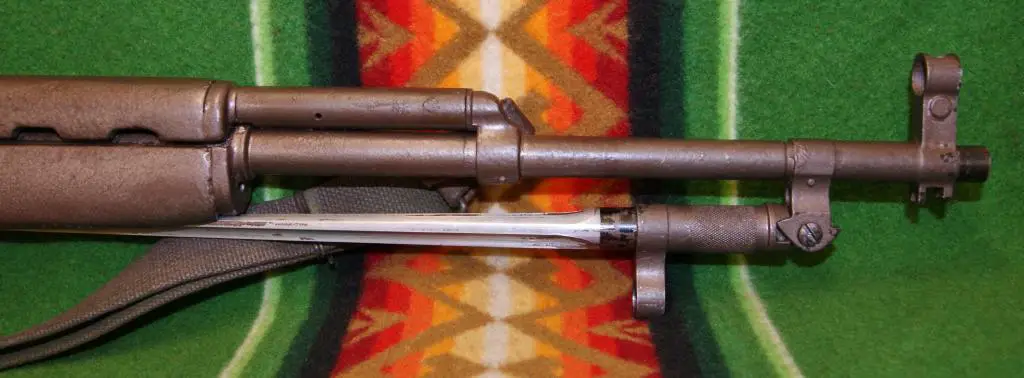 And if we look at the other side of the barrel, we’ll see the ever popular improvised wire keeper on the spray-painted sling. At least the Krylon has been partially cleaned off the bayonet. Or, maybe, didn’t stick to its satin finish in the first ever-lovin’ place.
And if we look at the other side of the barrel, we’ll see the ever popular improvised wire keeper on the spray-painted sling. At least the Krylon has been partially cleaned off the bayonet. Or, maybe, didn’t stick to its satin finish in the first ever-lovin’ place.
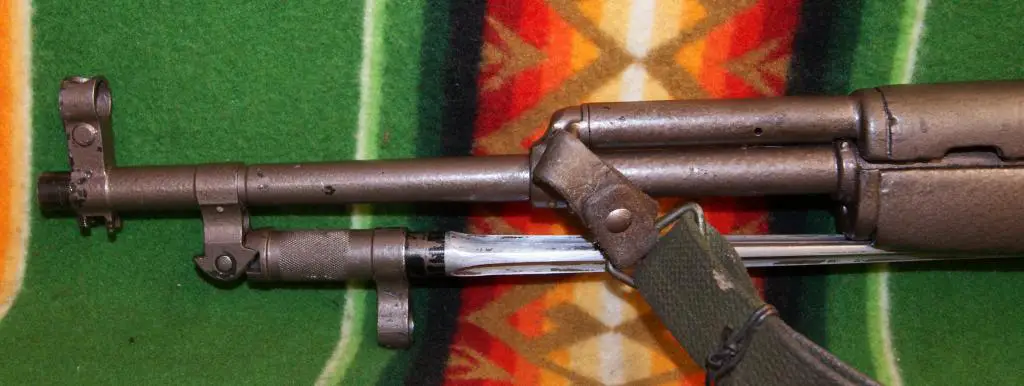 Somewhere in China, a gun guy is shaking his head and saying, “For this, we went through the Cultural Revolution and the Great Leap Forward?”
Somewhere in China, a gun guy is shaking his head and saying, “For this, we went through the Cultural Revolution and the Great Leap Forward?”
But wait, we didn’t tell you the best part. Here it is, verbatim from the listing, emphasis ours:
You are currently looking at a Chinese SKS Type 56 serial # 10329. 20″ barrel with a post front sight & 1000 meter adjustable rear.
Wood stock & handguard have been hot glued to the metal. Handguard can be taken off & gas pistons work freely. The follower in the magazine keeps it from opening all the way
The trigger works correctly & bore is mirror bright with deep rifling. The entire rifle has been spray painted.
Hot glued to the metal. Or in Bubba’s shop, “custom bedded.” Lord love a duck.
Will need a little TLC and cleaning before firing
Gee. Ya think?
Now, it’s not our intention to bag on the dealer selling this firearm. After all, they took it in trade from someone, quite possibly the Bubba that did this number on it, and they’ve discounted it about $100 on what they could have charged for it, pre-Bubba.
Wait, just thinking that this was a trade, we shudder to think what his next project will be.
We are selling this rifle just the way we got it. Will make a fun winter project or shoot it just the way it is.
And they do have a point. This is a potential project gun for a patient non-Bubba. Most of what he has done this time is reversible. There are a few reasons not to take on that project:
- Even valuing your time at $0, it will cost more to restore than the delta between this gun and a good one.
- It’s going to be messy. All that toxic Krylon has to go somewhere.
- The same amount of effort can better be spent on a firearm that’s higher-quality and in higher demand to begin with.
- The resulting gun will never be original again.
…But there’s also the joy to be had in taking something Bubba the Gunsmite™ (sic) has applied his trademark smiting to, and repair the damage he has done.
We’re weighing a bid. If we do it’ll be a project in these pages. But we have a lot of SKSes already (all non import marked Chinese ones, actually). And oy, the mess….
In the Read Pile: Guns, War, & Survival
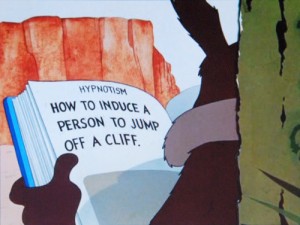 Each of these is either underway (yeah, we have a lot of books lying around spine-up), has recently been read, or is in the queue to be read. These are de minimus capsule reviews; if time permits, we’ll link the titles to their Amazon pages later today
Each of these is either underway (yeah, we have a lot of books lying around spine-up), has recently been read, or is in the queue to be read. These are de minimus capsule reviews; if time permits, we’ll link the titles to their Amazon pages later today
Gun books first, in alphabetical order by title; then war books, the same way, OK? We also have one survival-related book that’s neither a gun nor a war volume.
Gun Books
Accuracy and Precision for Long Range Shooting, by Bryan Litz. This is on order, not here yet. We also sprang for a number of Litz’s short articles on Kindle.
The Gun Digest Book of Firearms Fakes and Reproductions, by Rick Sapp. We thought this would be rather better than it is, but it’s pretty disjointed — almost as if someone assembled a pile of essays into a book. Above all, it lacks any kind of a simple checklist for buyers, and while there’s a lot of advice for sellers that might help them keep ethical, it’s scattered here and there. An Appendix called “Data on commonly faked firearms” includes data on Winchesters, Colt percussion and single-action revolvers, and Sharps firearms — period.
War Books
15 Minutes: Curtis LeMay and the Countdown to Nuclear Annihilation, by L. Douglas Keeney. As the title suggests, this is a somewhat maidenly, overwrought, handwringing look back at the Cold War war plans. It is somewhat knecapped by the author’s credulous attitude towards claimed nuclear weapons effects, and definitely crippled by a weak index and an utter absence of footnotes. There is a list of sources, but it’s anyone’s guess where any specific facts were found.
Battleground Pacific: A Marine Rifleman’s Combat Odyssey in K/3/5, by Sterling Mace and Nick Allen. We want to extract some of Mace’s experience as a BAR man and squad leader into a post of its own soon, but in the meantime, would recommend this searing and well-written combat memoir. Looking back at his time in combat from old age, Mace’s memories are still crisp; the writing is sometimes poetic, which we’re inclined to credit to hired-pen Allen. Some gormless New York publishing house sank a fortune into this book, and then sabotaged it by putting a stock photo on the cover, and worse, one that has adorned a plenitude of other covers. The win for you in that is that the hardcover has been widely remaindered (ours set us back all of $3.97 at Walmart), and the publisher did push many copies to libraries.
Bright Light: Untold Stories of the Top Secret War in Vietnam, by Stephen Perry. We recommend this SOG memoir highly. It’s not as polished or professional a book qua book as, for example, John “Tilt” Meyer’s books or John Plaster’s are, but that makes it more immediate and personal. Steve was the boy next door who went to do his Army service and was screened as a candidate by the then-usual method, the SF Screening Battery. He volunteered for and completed SF medic training, which he describes briefly, and then was assigned to the 7th Special Forces Group, then at Ft. Bragg, North Carolina. He volunteered for Vietnam the way it was done in those days, by calling Mrs Billye Alexander, who got him what he wanted. In Vietnam, he and his best friend were assigned to FOB-1, where he was given a choice: dispensary medic, or volunteer to run recon. Steve ran with several Spike Teams including Idaho, Oregon and New Jersey. Some of these stories are truly untold, and it’s good to have them.
No Need to Die: American Flyers in RAF Bomber Command, by Gordon Thorburn. The title refers to the fact that these Yanks weren’t called up, and generally, when they joined up, their country wasn’t even at war. Instead, they joined the Royal Air Force and flew with Bomber Command. While the Yanks who flew — and mostly, died in — fighters for the RAF have received a lot of attention, we’re not aware of any other book about Americans in Bomber Command. They served throughout the command, including in the 617 Squadron “dam busters,” and hit most of the famous RAF night-raid targets. If you haven’t read much about Bomber Command, the scale of the losses are staggering, and Thorburn’s detailed, moving portraits of the men who fought, and, in most cases, died, in RAF blue bring home the human aspect to that loss.
Sniper Elite: The World of a Top Special Forces Marksman, by Rob Maylor with Robert Macklin. Just started this story of a Briton who served in the Royal Marines and later in the Australian SAS. (So this is “Special Forces” in the rest-of-Anglophere sense, not in its more particular US meaning). Despite the off-putting title, it seems like a solid story so far.
Survival Related
The Biology of Human Survival: Life and Death in Extreme Environments, by Claude A. Piantadosi. This is a serious, academic tome that’s also quite interesting: Piantadosi asks questions that interest all of us: what about extreme environments kills people? Altitude, depth, g-force, heat, cold, toxicity, you name it. Can the lethal aspect or degree of environmental conditions that is fatal be quantified with confidence? What do the case studies say? And, what measures might be undertaken to secure survival in those hostile environments? If these questions interest you, this book will, too.
When guns are outlawed, only outlaws will have knives
 This lady is Elizabeth Yanez, 42. Or, we should say, was Elizabeth Yanez, who is now no longer with us, or more to the point, with her Whitter, California family. Why not? Because two LA scumbags felt entitled to a parking spot and savaged her with a knife.
This lady is Elizabeth Yanez, 42. Or, we should say, was Elizabeth Yanez, who is now no longer with us, or more to the point, with her Whitter, California family. Why not? Because two LA scumbags felt entitled to a parking spot and savaged her with a knife.
We first saw the story at the Las Vegas Review-Journal. The R-J had a bare-facts report:
The woman’s son told KTLA the argument over a parking spot escalated until a man got out of his car and stabbed the woman, 42-year-old Elizabeth Yanez, multiple times in her neck and back. Yanez was taken to the hospital, where she later died.
Reggie Cervantes, 22, and Brenda Rangel, 19, are being held on murder charges in lieu of $1 million bail.
via Mom killed in front of her children over parking spot | Las Vegas Review-Journal.
We found the story at KTLA, which had much more detail. She was murdered in front of her two adult children, and the murderers fled the scene. And both the man and woman — Cervantes and Rangel — stabbed her in the neck, and as she turned away, back. She was transported to the University of California at Irvine Medical Center, where she died of her wounds.
Officers responding to a report of a fight in the parking lot, found Elizabeth Yanez lying on the ground with multiple stab wounds to her neck and back, according to a news release from the Whittier Police Department.
The 43-year-old mother of two was transported to UCI Medical Center where she later died.
Her adult children, who witnessed the attack, said their mother had been stabbed by a man and woman over a parking space.
“It escalated,” son Daniel Crable said. “It went from one to 10 in a matter of seconds. The next thing you know this man is out of his car.”
Detectives were able to get fingerprints from the victim’s car which led to the arrests of Reggie Cervantes, 22, and Brenda Rangel, 19, in South Los Angeles.
Note that the cops got a hit on the prints the murderers left on the car. Stop and think about that for a minute: why did they get that hit? Because the murderers, Cervantes and Rangel, were “in the system” — career criminals already at 22 and 19.
Now, they’re not going to murder anyone for a while, even in California.
Guns don’t kill people. People like Cervantes and Rangel kill people. Sometimes they do use guns. But a knife is a deadly weapon available to anybody. You’re probably sitting within seconds of holding one right now. So why aren’t you stabbing people over parking places?
Tentative conclusion: you’re not like Cervantes and Rangel.
A Weapon is Where You Find It
 Who knew that Canadians in their Parliament would defend themselves with such intensity?
Who knew that Canadians in their Parliament would defend themselves with such intensity?
By now, everyone knows about Sergeant at Arms Kevin Vickers, a middle-aged retired Mountie in a ceremonial position that often involves dressing funny and carrying weird implements, to wit, a Ceremonial Mace (carried at the opening of Parliament, and called “a Foolish bauble” as log ago as 1650 or so, by Oliver Cromwell — of course, Ollie was talking about the English version, but that was the origin of the Canadian tradition). Vickers dashed to his desk, picked up his Smith & Wesson 5906, and returned to the scene of the fray, curing all the ills of the Sudden Jihad Syndrome sufferer with a couple of well-placed therapeutics. “Readiness is all, said Hamlet; Mr Vickers and company were ready,” the Globe and Mail intoned in a satisfied editorial.
Yeah. We knew about all that.
 But we didn’t know about what the parliamentarians themselves did. Imagine a gunman loose in the halls of the US Capitol — it’s not hard to figure out who would pee himself, who would hide, and who would vie with one another to draft the most abject terms of surrender imaginable.
But we didn’t know about what the parliamentarians themselves did. Imagine a gunman loose in the halls of the US Capitol — it’s not hard to figure out who would pee himself, who would hide, and who would vie with one another to draft the most abject terms of surrender imaginable.
The Canadian politicians did none of that. Now, the PM did hide in a closet, which is only partly excused by the fact that it was his bodyguards that stuffed him in there. At least he had the stones to reject his American counterpart’s invitation to call this “workplace violence,” American-style. But the rank and file MPs took action:
Some positioned themselves on risers that flanked doors, ready to attack an assailant.
“There were 15 flags up at caucus and all but two were taken down,” one MP recalled.
“These guys were up there holding these spears ready to impale anyone who came in,” the source said.
“It was that or get mowed down,” the member of Parliament said of the threat posed by a gunman who was ultimately shot dead by Parliament Hill security.
The MPs-turned-halberdiers (or at least, pikemen) didn’t know that the PM was still in the caucus room, or the closets thereto, until a flying wedge of Mounties swept him out of there.
It looks like Canada will be springing for new flags, as the MPs who manned-up during the attack have grown attached to theirs.
Some MPs kept their flagpole weapons as souvenirs.
“Everyone was taking their spears home,” the MP said. “I’m going to frame mine.”
Tory MPs reunited with Mr. Harper Wednesday evening at the Foreign Affairs building and Democratic Reform Minister Pierre Poilievre brought his spear as a memento, another source said.
We have no idea what a Democratic Reform Minister does, and probably wouldn’t like it if we did, but we can’t help but have warm feelings to our fellow North American, Minister Poilievre. We’ll even suck it up and have those warm feelings in English and en français, in deference to the way our neighbors do things. Toujours l’audace, Pierre, to quote another famous Francophone (The ill-fated Georges Danton, specifically).
Remember, your weapon is your mind. The raw materials necessary to bring those conceptual weapons to immanence are all around you.
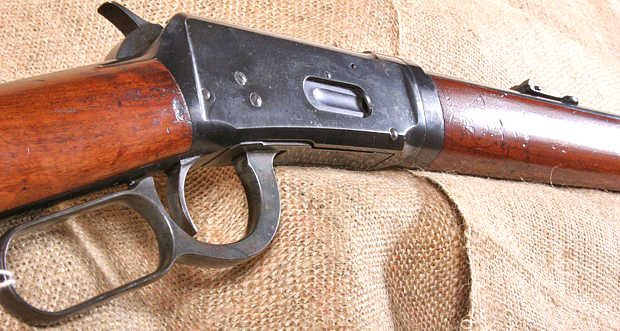
File photo of a 94 — This one is Teddy Roosevelt’s Maxim-silenced version, actually, but it was the 94 photo at hand.
Many have commented on the excellence of Vickers’s performance, but we also have to highlight that he went up with a pistol against Jihad Boy’s long gun (a .30-30 Winchester 94, according to Dean Weingarten). Fat lot of good the rifle did the wrongdoer, once Vickers showed up: Canada 1, Allah 0 from that point on.
(Does Larry Vickers have cousins in Canada, or what?).
The Moslem assailant did nail two Canadians before Vickers terminated his spree: one soldier, Nathan Cirillo of the Argyll & Sutherland Regiment, and one of the regular security guards. The guard, whose name was not released as far as we know, will recover, but Cirillo passed away from blood loss as a pick-up team of first-aid-trained passersby urgently strove to keep him alive.
The gunman fired four shots at Cirillo. The Canadian trooper and his partner, ceremonial guards at the National War Memorial, had empty C8 rifles. He appears to have bled out from a compromised artery due to an abdominal wound.
Many Canadians seem shocked that the terrorism has come home. In the past, the terrorists asps suckled at Canada’s breast, like Omar al-Khadr, have turned their fangs on America. But it was just a matter of time.
Rather shamefully, Canadian Armed Forces have ordered their men not to wear their uniforms in public. Here’s hoping they also give the two fellows at the War Memorial, and any other ceremonial guards, some pointy bullets. (The details are closely held, for sensible reasons, but the guard mount at, for example, the Tomb of the Unknown Soldier, the moral equivalent of Canada’s War Memorial cenotaph, has always had deadly force capability). That would have resolved this whole thing without terrorizing the MPs.
Whether Canada (or the US, for that matter) wants to do something about the cuckoo’s egg of Moslem immigration is a policy question, one the parliamentarians may consider when they put aside their improvised spears. But whether to give guards live ammunition is dead in the lane of a Weapons Man. And we say: if you don’t trust your guards with bullets you probably shouldn’t trust them with weapons. And if you don’t trust a man with weapons, he probably should be confined or at least under supervision.
Another Vintage Fighter, Another Expensive Landing
A couple of weeks ago, it was a rare, multi-million-dollar Focke-Wulf 190. This time, the minor but expensive mishap is to a less rare, but still multi-million-dollar P-51 Mustang. Only one landing gear extended, so pilot (and owner) Jeff Pino retracted the gear. The gear came up, but not the gear doors, which hung down and made initial contact during a planned, and well-executed, gear-up landing.
This is a great report by Phoenix, AZ Channel 3’s News Copter 3 pilot/reporter, Bruce Haffner. (The video, that is. Haffner’s written report, excerpted below, is a bit dry compared to his video report — and sky-cam footage — of the mishap).
MESA, Ariz.- The pilot of a rare airplane was forced to make an emergency belly landing on Thursday.
It happened at Phoenix-Mesa Gateway Airport.
The $2.2 million 1944 P-51 Mustang, known as the “Big Beautiful Doll,” had a problem with its landing gear.
The plane was going to be part of the Copper State Fly-in this week in Casa Grande.
via Pilot of rare plane forced to make belly landing | azfamily.com Phoenix.
Here’s a few images from the video with captions explaining what’s happening.

Moments before touchdown on the hanging inboard main-gear doors, the pilot has the runway made and secures the engine.
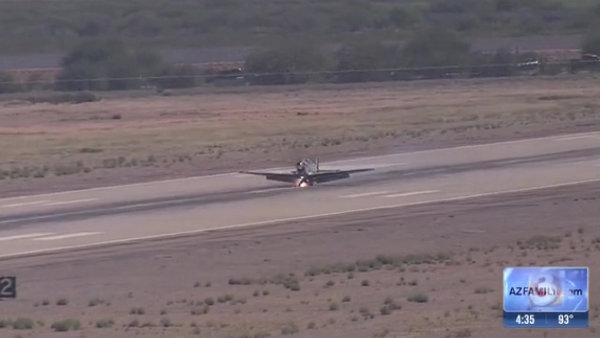
The gear doors destroy themselves in a shower of sparks as they get squeezed between the five-ton plane and the tarmac. The engine is shut down and only inertia is turning the prop,

The P-51 slides to a stop. Two of the still prop blades scrape along the runway, but the others are saved, and the costly hub will probably be okay to fly again — not to mention the very expensive Merlin engine and its vulnerable gearbox.
Any landing you can walk away from…
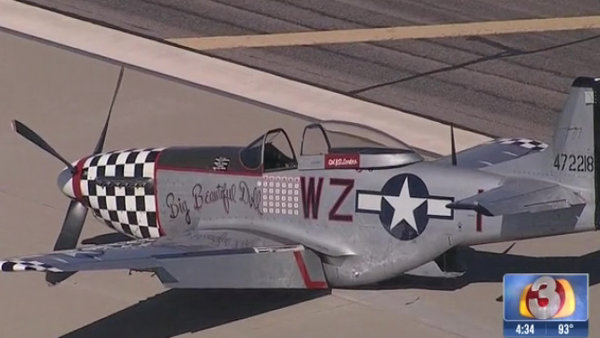
…is a good one. One where you can use the airplane again is a Great one. This one’s only Good at this point, but thanks to the skill of the pilot, this plane will fly again.
The wartime P-51 “Big Beautiful Doll” was so attractively decorated, and its original pilot, John Landers, so successful, that its markings are frequently copied by owners of Mustang survivors. Landers was an ace in P-40s against the Japanese, and then became an ace again in Europe, flying the P-38 and P-51. He ended the war with 15.5 kills total. Big Beautiful Doll, the name of a popular song of the era, was lucky for Landers, but perhaps today it’s a hard-luck name; Briton Rob Davies bailed out of a similarly painted Mustang after surviving a mid-air collision with an A1D Skyraider at a 2011 airshow:
Davies told his story to the Guardian in 2011.
The aircraft that made the gear-up landing in Colorado is generally accepted to be USAAC Serial Number 44-63634, but is registered as 44-85634 (which was not a wartime P51 serial number). It flies under the civilian registration N351BD and is owned by its pilot, Jeff Pino, who bought it this spring.
Arizonans could have been excused for thinking they were seeing double. After the Mustang belly-up last Thursday, a similar looking Thunder Mustang, a subscale carbon-fiber Mustang powered by a Falconer V-12 engine that was designed for air racing, lost oil pressure Friday morning and crashed into scrubland east of town. The airplane was substantially damaged, and the pilot suffered unspecified but non-life-threatening facial injuries.
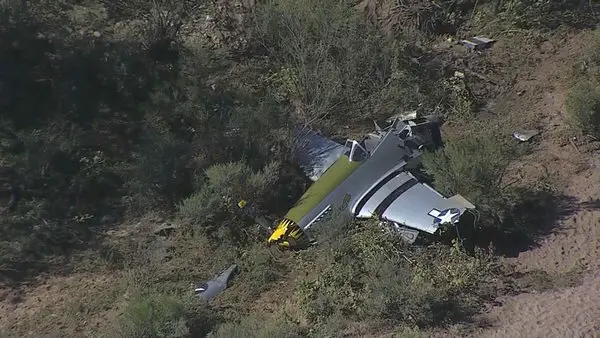
Thunder Mustang wreckage. If this was a car, it’d be a total loss (and it probably is, to the insurer), but the plane was built from a kit in the first place and might actually be repaired.
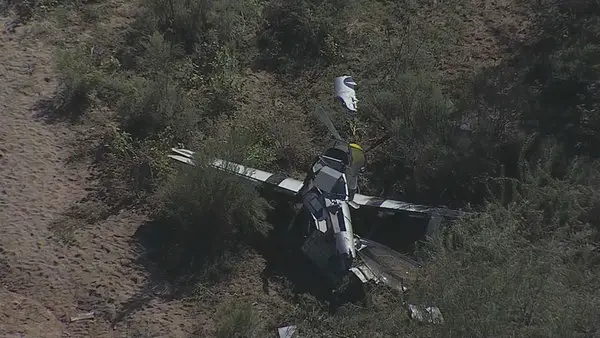
From another angle, showing the broken back of the plane. The pilot was lucky to escape with his life.
The Mustang is the most popular of surviving World War II fighters. Of over 15,000 made, almost 300 survive, 171 of them airworthy. Whether that’s because of its clean, attractive lines, its remarkable history, its high performance, or the simple fact that aircraft restoration and exhibition got its start in the United States, the Mustang’s homeland, is anybody’s guess. But there are basically only two kinds of pilots: those who have flown the Mustang, and those green with envy.
Remember, flying small and vintage planes is safe. For these two pilots, even crash-landing turned out to be safe!
Sunday Somnambulism
Well, it feels like we are sleepwalking here. Maybe ‘ not. Maybe we’re actually awake, and just wish we weren’t. But it does feel like sleepwalking.
Or does it? We don’t have any recollection of sleepwalking, ever, and have never been accused of any such thing. Consequently, we have a degree of skepticism that such a thing even exists. It sounds like the sort of thing psychologists make up to sound clever, and hide the fact that nobody knows a damned thing about what goes on inside a homo sapiens’s brain housing group. We’d better look it up.
Heh, apparently it is a real thing. Mayo Clinic says so. So does the National Institute of Medicine.
Guess we better start believing in it.
Symptoms of sleepwalking include:
- Acting confused or disoriented when the person wakes up
- Aggressive behavior when woken uip by someone else
- Having a blank look on the face
- Opening eyes during sleep
- Not remembering the sleep walking episode when they wake up
- Performing detailed activity of any type during sleep
- Sitting up and appearing awake during sleep
- Talking in sleep and saying things that do not make sense
- Walking during sleep
Wait, what? “…saying things that do not make sense?” We guess whoever wrote that never experienced an election year
This Day is Called the Feast of Crispian
So, Miguel at GunFreeZone posted video of the “Band of Brothers” speech from the excellent cinema version with the talented and committed Kenneth Branagh (then, about the age Henry V would have been). It’s our favorite version, but it’s far from the only one.
Here’s the traditional way of doing it. Mark Rylance, a great stage actor with a shelf full of Tony and Olivier best-actor awards, on stage at Shakespeare’s Globe Theater, in 1997.
Rylance’s Henry leaves us cold; the quintessential English hero ought to have an English accent, and this rings to us as nearly a Scots one (Rylance is as English as a bowler hat, but grew up partly in America). He’s got a different sort of the common touch from the one Branagh delivers. Maybe you will like it — horses for courses, to quote another great Briton.
The classic performance pre-Branagh was, of course, the 1944 one by Sir Laurence Olivier, then in his late thirties. It clearly was inspirational to Branagh. Olivier (who was, like most of these actors, of quite common origins) perhaps takes the accent too far in the direction of “plummy.”
A recent TV version had a heartfelt delivery by Tom Hiddleston, complete with a suitably 2013 black York among his anachronistically diverse followings. This video is only the second half of the speech, but Hiddleston does well enough, and his accent strikes us as just about right:
Every military unit seems to have someone who can do the St Crispian speech — even fictional ones, like Private Donnie Benitez from the forgotten Danny DeVito vehicle (directed by Penny Marshall), Renaissance Man. In the movie, DeVito has to teach remedial English to a class of the sort of hollow-braincase losers that Hollywood imagines soldiers to be. Shakespeare turns out to be what engages them:
There’s a whole raft of parodies and ironic uses of the speech, but note that that was not the intent of the Renaissance Man version. Instead, it shows the development of the Benitez character, and bedamned if the drill sergeant character doesn’t undergo the very elevation of station that Henry V promises to his loyal few in the speech. It was a nice touch we didn’t notice on first viewing the film.
And, for comparison’s sake, here is Branagh, although you can go over to Miguel’s and see him there (and Miguel always has something to read).
For an idea of how The Speech has changed war itself, here’s an older and experienced Branagh reciting, word for word, the pre-war speech of Col. Tim Collins of the Royal Irish Regiment on 19 March 03, the evening before the Royal Irish went in.
Collins seemed to have taken Branagh’s performance as Henry on board — and now, here’s Branagh playing him. How recursive can one military tradition get?
Whilst most of the focus has always been on “we few, we happy few, we band of brothers,” this speech abounds in phrases that resound through the centuries, especially in the hearts of men who have faced combat.
“This story shall a good man teach his sons….” Yes. But our favorite must be, “All things be ready if our minds be so.” Amen.
Hat tip, Miguel, mi hermano.
A Tale of Two Ebola-Research Mishaps
 Today, as the Washington Post tells this story. It has the feel of a single-source anecdote, of being “too good to check.” It is neat, compact, no one is mentioned by name, and there’s a moral to the story: ready-made for narrative-addicted Posties.
Today, as the Washington Post tells this story. It has the feel of a single-source anecdote, of being “too good to check.” It is neat, compact, no one is mentioned by name, and there’s a moral to the story: ready-made for narrative-addicted Posties.
But it is what happened, says the Post, to a Russian infectious-diseases lab tech.
The Russian Mishap as told by the Post
She was an ordinary lab technician with an uncommonly dangerous assignment: drawing blood from Ebola-infected animals in a secret military laboratory. When she cut herself at work one day, she decided to keep quiet, fearing she’d be in trouble. Then the illness struck.
“By the time she turned to a doctor for help, it was too late,” one of her overseers, a former bioweapons scientist, said of the accident years afterward. The woman died quickly and was buried, according to one account, in a “sack filled with calcium hypochlorite,” or powdered bleach.
The 1996 incident might have been forgotten except for the pathogen involved — a highly lethal strain of Ebola virus — and where the incident occurred: inside a restricted Russian military lab that was once part of the Soviet Union’s biological weapons program. Years ago, the same facility in the Moscow suburb of Sergiev Posad cultivated microbes for use as tools of war. Today, much of what goes on in the lab remains unknown.
via Ebola crisis rekindles concerns about secret research in Russian military labs – The Washington Post.
In fact, there is a case of a Russian researcher dying of laboratory-acquired ebola — in 2004. Here’s Judith Miller at the New York Times. University of Minnesota Center for Infectious Disease Research and Policy in 2004. However, the unfortunate Russian researcher in 2004 was in Novosibirsk at the Vector (formerly Biopreparat) facility, not near Moscow.
Now, we’re familiar through work with a similar mishap in the United States, with a somewhat better outcome, that happened about the same time.
The American Mishap
 On February 11, 2004, a scientist was injecting a test treatment into laboratory animals (mice) deliberately infected with a mouse-adapted strain of Ebola Zaire, at the US Army Medical Research Institute for Infectious Diseases in order to study the disease. She inadvertently stuck herself with the needle. It went right through her bio-safety suit glove and her surgical glove into the soft muscle of her hand. (She was trying to inject the sample into the mouse’s belly, whilst holding the mouse in her hand). She was in a Bio Safety Level-4 containment lab at the time, the strictest and most inconvenient of medical precautions.
On February 11, 2004, a scientist was injecting a test treatment into laboratory animals (mice) deliberately infected with a mouse-adapted strain of Ebola Zaire, at the US Army Medical Research Institute for Infectious Diseases in order to study the disease. She inadvertently stuck herself with the needle. It went right through her bio-safety suit glove and her surgical glove into the soft muscle of her hand. (She was trying to inject the sample into the mouse’s belly, whilst holding the mouse in her hand). She was in a Bio Safety Level-4 containment lab at the time, the strictest and most inconvenient of medical precautions.
The accident and its aftermath has been written up by Kortepeter et al. in the Journal of Emerging Infectious Diseases in 2008. Here’s their description of the accident:
The person had been following standard procedure, holding the mice while injecting them intraperitoneally with an immune globulin preparation. While the person was injecting the fifth mouse with a hypodermic syringe that had been used on previous mice, the animal kicked the syringe, causing the needle to pierce the person’s left-hand gloves, resulting in a small laceration. The virologist immediately squeezed the site to force the extravasation of blood. After decontamination of the blue suit in the chemical shower, the injured site was irrigated with 1 liter of sterile water and then scrubbed with povidone-iodine for 10 minutes.
In terms of exposure risk, the needle was presumed to be contaminated with virus-laden blood, although it was suspected that low levels of virus were present on the needle. The animals had not yet manifested signs of infection, and much contamination may have been removed mechanically when the needle pierced the gloves. The local decontamination of the site also reduced potential for infection.
BSL-4 is used for pathogens which are highly contagious, lethal, and for which there are no suitable vaccines or therapies. The most common BSL-4 agents are hemorrhagic fevers, including filoviruses like ebola, Marburg, and Lassa; and CCHF. (We’re probably forgetting a few). Many of the nastiest nasties like Yersinia pestis (plague), yellow fever, Rickettsia spp., are BSL-3 because there exists an approved or experimental vaccine or treatment for them in humans.
BSL-4 implies, among other things:
- Hermetically-sealed rooms with highly-engineered HVAC systems to control any air interchange; HEPA filters catch even the tiniest viral particles. The BSL-4 facility is physically isolated from non-BSL-4 buildings or areas. Operations are conducted in accordance with a detailed procedures manual.
- Permanent underpressure (so air would never flow out if the seal leaked or was breached; a truly leak-proof seal is a near impossibility, but it can be approached asymptotically).
- At a minimum shower-in, shower-out through an airlock.
- Minimum number of people allowed in. All personnel must have (extensive) BSL-4 general and facility-specific training.
- Everyone inside must wear a positive pressure personnel suit. Every individual’s suit has a segregated air supply.
- No clothes from outside go in, no clothes from inside come out.
- Anything that does come out, comes out through sterilization measures, usually an autoclave.
- Even inside the BSL-4 containment, work with BSL-4 pathogens takes place under hoods or (preferably) in cabinets.
These are international rules and we’d assume the Russians follow them also.
Anyway, she thought the plunger didn’t move, but instantly reported the accident, and took basic first-aid measures. And things started to happen. Because an ebola patient is not infectious for 24 hours, she was allowed to go home and pack for a month away from home. (Home wasn’t very far, because the same facility where she worked hosted her quarantine area). Then she came back to USAMRIID, and walked through the round stainless-steel vault door of RIID’s “Patient Isolation Suite,” or, as everybody called it, The Slammer. There she would stay for 21 days.
If she lived that long.
They made it as comfortable as possible for her. She had a computer and TV, and could stay in touch and read the news — including reports on her own health in the local paper — on the internet. She had a VCR (yeah, not DVD) with a bunch of old movies.
There were basically three possibilities: (a), she hadn’t been infected; (b), she had, and would soon be dead of the disease; or (c), she had been infected, but would be one of the minority that beat the disease. The postdoctoral researcher was young, but adult, and healthy, which helped. And all the skills of all of RIID and its many peer organizations and cooperating scientists were galvanized into action.
An Experimental Hail-Mary Pass
In addition to the other precautions, RIID scientists and their industry and academic peers took a look at whether any experimental therapy might work. A small company in Corvallis, Oregon, AVI BioPharma (formerly AntiVirals, Inc). had been working for years on a concept called Morpholino Oligomers (called PMOs sometimes, abbreviating a longer name), which interposes a synthetic therapeutic molecule — the PMO — between the patient’s cell’s nucleic acids and the single-stranded RNA virus causing the disease. (Viruses use the infected organism’s cellular mechanisms to reproduce themselves). At the time it was a highly experimental therapy, unproven not just for ebola in humans, but for any disease in humans, any primate, or even any laboratory animal.
Because viruses need living cells to reproduce, the scientists at AVI were big believers in direct-to-animal testing, using rodents, ferrets and non-human primates. But with just 21 days max, if Researcher X had been infected, there would be no time for testing. Worse, given the state of technology of 2004, it took about 8 days to make the morpholino in potentially-therapeutic quantities, but it took several days to sequence a pathogen’s genome, and the gene sequence of the infectious virus strain was necessary to start morpholino development! Here, the researchers caught a break: since RIID was working with a known ebola strain, they had a good sequence in-house. The gene sequence of the virus was blasted through the internet to AVI, and morpholino production started. In a very short time, a tiny vial of potentially life-saving — but completely untested — ebola therapeutic morpholino was on a jet from Oregon to Maryland.
It was eight days after the researcher’s lab accident.
A Lucky Break
Medicines are tightly controlled in the various nations of the world. The US has an early-20th-century food-and-drug-act with many subsequent amendments, one that tends to strangle real medical research — like morpholino research — while giving legal cover to bogus nostrums and snake-oils (all the stuff that advertises on radio; it’s all crap). But giving an experimental molecule that hasn’t even been given to a mouse to a human is strengstens verboten. Still, if Researcher X had broken with ebola, they’d have given it to her. But the researcher got a lucky break. She never tested positive for the virus, never developed systems, and walked out of the Patient Containment Suite for the last time on 3 March 2004, 21 days after entering.
If she had broken with ebola, perhaps morpholino research would be further along today. But perhaps she’d be dead; there is that, and we wouldn’t wish her dead to advance science.
Science will still get there.
How Science is Getting There Today
Most of the players have moved on. The top guy in RIID’s program then went over to DHS’s expensive, duplicative, and troubled biodefense program. AVI BioPharma has become Cambridge, Massachusetts -based Sarepta, which continues morpholino research and recently reported successful non-human primate trials for a morpholino therapeutic for Marburg virus. Like ebola, Marburg is a Cat A bioterrorism threat agent, and Sarepta’s research has taken place in collaboration with USAMRIID.
One thing has changed. A 2011 rebuild of several buildings at USAMRIID eliminated the Slammer. RIID is hard up for space, and the Patient Isolation Suite hadn’t been used since 2004. The 2004 incident described here was its first use since 1985; from 1972 when the Slammer opened to 1985, 20 other patients were considered and 17 were admitted, some of which for diseases later downgraded to BSL-2 or -3 pathogens. None of them broke with the disease; it seems like every case was an exercise of due caution. The managers of RIID concluded that any future BSL-4 patients, including suspected ebola exposures, could be adequately contained in local hospitals. The duplicative new DHS BSL-4 facility at Ft Detrick (NBACC), and a triplicative planned new facility (NBAF), an exercise in Nebraska Avenue empire-building which DHS is extremely defensive about, also do not contain any facility for isolating infected researchers.

Kevin was a former Special Forces weapons man (MOS 18B, before the 18 series, 11B with Skill Qualification Indicator of S). His focus was on weapons: their history, effects and employment. He started WeaponsMan.com in 2011 and operated it until he passed away in 2017. His work is being preserved here at the request of his family.

